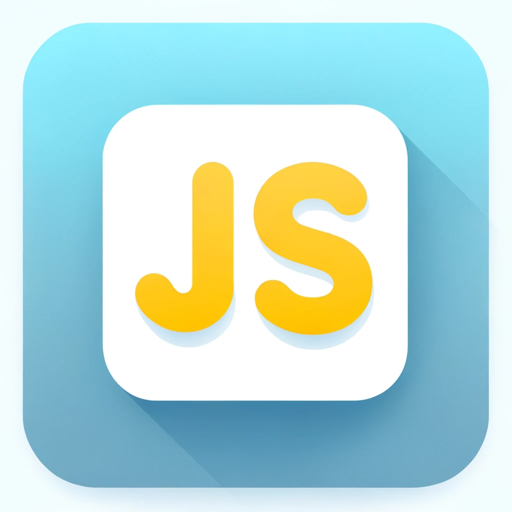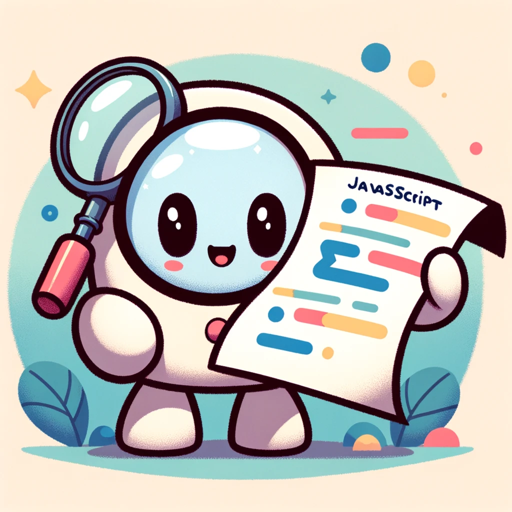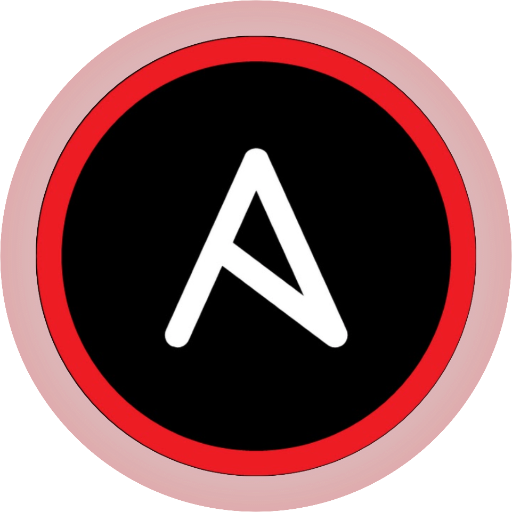Javascript-JavaScript usage guide
AI-powered JavaScript Guide
💻 Create a full CRUD app with Node.js and Express
🌐 Create a full webpage using HTML, CSS and Js
🪲 Find any bug or improvement in my code
💡 Teach me a useful skill or trick in Javascript
Related Tools
Load More
code: python java c html sql javascript react web+
The worlds most powerful coding assistant.

JavaScript GPT
JavaScript coding assistant.

JavaScript GPT
Your go-to expert for all things JavaScript, Node.js, TypeScript, jQuery, React, Vue, and Angular, ready to guide learners at any level with ease and insight.

Advanced JavaScript Assistant
A friendly JavaScript programming assistant, ready to assist you.

JavaScript Guru
Master Class - Teaching and creating code examples.

Javascript God
Embodies pinnacle of Javascript expertise.
20.0 / 5 (200 votes)
Introduction to JavaScript
JavaScript is a high-level, versatile programming language primarily used for web development. Created by Brendan Eich in 1995, it was initially designed to make web pages interactive. Today, JavaScript is a core technology of the World Wide Web, alongside HTML and CSS. It enables client-side script to interact with the user, control the browser, communicate asynchronously, and alter document content. JavaScript's ability to run in any browser without requiring additional software makes it a powerful tool for developing dynamic and responsive websites. Example: A typical use of JavaScript is to create interactive forms on websites that provide immediate feedback to users, such as validating email formats or showing password strength indicators as users type.

Main Functions of JavaScript
DOM Manipulation
Example
Using `document.querySelector` to select an HTML element and change its content or style.
Scenario
A web developer uses JavaScript to create a live search feature. As the user types in the search bar, JavaScript dynamically updates the list of displayed results without requiring a page reload.
Event Handling
Example
Using `addEventListener` to attach event handlers to elements.
Scenario
JavaScript is used to create an interactive photo gallery. Clicking on a thumbnail image triggers a JavaScript function that displays the image in a larger view with animations.
Asynchronous Operations
Example
Using `fetch` to make asynchronous HTTP requests to a server.
Scenario
A developer integrates a weather widget into a website. JavaScript periodically fetches data from a weather API and updates the display without reloading the page, providing users with real-time weather updates.
Ideal Users of JavaScript
Front-End Web Developers
These developers use JavaScript to enhance user interfaces and experiences. JavaScript allows them to create interactive elements, handle user input, and integrate various APIs. They benefit from JavaScript's capabilities to create responsive and dynamic web applications that improve user engagement.
Full-Stack Developers
Full-stack developers leverage JavaScript on both the client side and the server side (using environments like Node.js). This enables them to build comprehensive applications where the front end interacts seamlessly with the back end. JavaScript's versatility helps them maintain consistent development practices across different layers of their applications.

How to Use Javascript
1
Visit aichatonline.org for a free trial without login, also no need for ChatGPT Plus.
2
Install a modern web browser like Chrome, Firefox, or Edge, as they come with built-in JavaScript engines.
3
Open the browser's developer tools by right-clicking on the webpage and selecting 'Inspect' or pressing F12, then navigate to the 'Console' tab to write and test JavaScript code.
4
Set up a local development environment by installing a code editor such as Visual Studio Code, Sublime Text, or Atom, and create a new HTML file to embed your JavaScript code.
5
Learn and practice JavaScript fundamentals like variables, functions, loops, and events through online resources, tutorials, and documentation from sites like MDN Web Docs.
Try other advanced and practical GPTs
Flutter
AI-powered cross-platform app development

Circuit Helper
AI-powered circuit design and simulation guidance.

Viral Video Wizard
AI-Powered Content Creation Simplified

Mind Map Constructor
AI-powered interactive mind mapping

¡Hola! ¿Qué tal?
AI-enhanced Spanish translation and correction.

Salesƒorce Architect Pro
AI-Powered Salesforce Optimization and Guidance

Angular
AI-powered Angular development made easy

Ansible
AI-powered IT automation

Thermo Lecturer
AI-powered Thermodynamics Insights

Docker Helper
AI-Powered Docker Assistance

Python GPT Guru
AI-powered Python solutions, simplified.

Jewellery Designer Image Generator
AI-Powered Custom Jewelry Design Made Easy

- Web Development
- Game Development
- Mobile Apps
- Interactive UI
- Server-Side
Javascript Q&A
What is JavaScript used for?
JavaScript is used for creating interactive web pages, building web and mobile apps, game development, and server-side programming with frameworks like Node.js.
How do I declare a variable in JavaScript?
You can declare a variable in JavaScript using the `var`, `let`, or `const` keyword, for example: `let x = 10;`.
What are JavaScript functions?
JavaScript functions are reusable blocks of code that perform a specific task. They are defined using the `function` keyword followed by a name, parameters, and a block of code.
How can I debug JavaScript code?
You can debug JavaScript code using the developer tools in modern browsers. Use breakpoints, console logs, and step-through debugging to identify and fix issues.
What is the Document Object Model (DOM)?
The DOM is a programming interface for HTML and XML documents. It represents the page so that programs can change the document structure, style, and content dynamically.